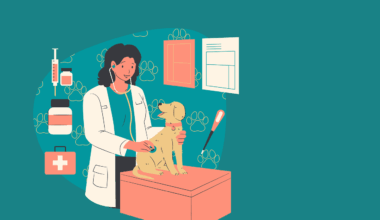Building Trust: Helping Your Dog Feel Safe at the Vet
Taking your dog to the veterinarian can often provoke feelings of anxiety. To ease this apprehension, trust builds over time through consistent positive experiences. First, establish a routine of visiting the vet that promotes the notion of an enjoyable outing. Use simple, enjoyable activities such as a brief walk or approaching favorite areas upon arrival. It’s vital to ensure that your dog feels relaxed before entering the clinic. Second, familiarize your dog with the facility. If possible, visit the clinic before an appointment, allowing them to explore the environment without the pressure of medical activities. This helps alleviate fears associated with unfamiliar spaces and noises. Additionally, consider bringing along their favorite toy or blanket, which can offer comfort and a sense of normalcy. Positive reinforcement plays an essential role in your dog’s training. Reward calm behavior with treats or praise, reinforcing that good things happen at the vet. Lastly, remain calm yourself; dogs often take cues from their owners. A relaxed handler promotes similar emotions in their pet. With gradual exposure and consistent positive interactions, seniors and puppies alike can learn to trust their vet visits.
Introduce your dog to the vet by creating a positive experience. Use treats, allowing them to associate the place with good feelings. Before entering the clinic, take a moment to stand by the door and reward your dog for calm behavior. Gradual introductions to the vet staff also help, as familiar faces can reduce stress levels. Ask the staff if they can give your dog a treat when you visit, easing any fear. Regular visits should not always be for vaccinations or checks, providing opportunities for unrestricted interactions. Encourage socialization with various staff members during these trips, making the vet’s office a friendly place. Understanding your dog’s body language is crucial here; lookout for signs of fear and anxiety, such as raised hackles, a tucked tail, or constant whining. Respond to these signs gently and slowly, using reassuring words and scratches. Inform your vet about their behavior during visits, as this knowledge allows adjustment in approach where necessary. Consider training classes specifically aimed at vet visits, focusing on calming techniques that can greatly enhance your dog’s comfort levels when veterinary care is required.
Establishing Trust Through Play and Training
Utilizing playtime and training can further aid in building trust. Teaching specific commands or tricks can foster a connection between you and your dog. Engage them in activities like fetch or tug-of-war. These are not just fun but also serve as bonding experiences that help solidify trust. A good command for your dog is ‘stay.’ Start with short durations, rewarding your dog when they remain put. This practice instills patience and a sense of security. Additionally, incorporating desensitization training can build confidence in environments that trigger anxiety. Create positive associations through gradual exposure to unfamiliar stimuli found in vet clinics, like scales or sounds. Practice visiting the vet during off-hours when it is less crowded. This allows your dog to explore without feeling overwhelmed. During this time, offer treat rewards for calm behavior, enhancing your dog’s comfort in the space. Encouraging consistent training sessions outside the vet environment focuses on reinforcing commands will also ease their general anxiety. This approach creates a cohesive understanding that the vet experience is part of their regular routine—not something to dread, ensuring a smoother visit when necessary.
Another significant aspect of preparing for vet visits involves practicing handling techniques that mimic what might happen at the clinic. Start conditioning your dog to being touched and handled. For instance, gently inspect their ears, paws, and mouth at home, giving them treats after each interaction. This will help them get used to being handled, which might happen during vet visits. Gradually build these sessions up, incorporating slight variations in grooming and handling. When visiting the vet, allow staff to perform similar actions, reinforcing to your dog that their routine is normal. Consider enrolling them in basic grooming classes, where similar handling occurs in a controlled environment. Positive reinforcement is a game-changer here. A simple ‘good boy/girl’ or a few tasty treats at these moments will go a long way. Moreover, practice this strategy with toys or equipment your dog might face, such as a stethoscope or thermometer, explaining each item to familiarize them. This preparation ensures they are less likely to be startled, making future visits less intimidating. Taking these small yet significant steps can dramatically influence how your dog perceives vet visits, transforming potential anxieties into manageable experiences.
Health Checks Become Routine
Incorporating regular health checks at home can normalize visits to the vet and reduce anxiety. Learning simple checks, such as monitoring their weight and feeling for any unusual lumps or bumps, can instill early awareness of your dog’s health status. Practicing these checks creates a familiar routine, making your dog comfortable with touch and examination. Regular grooming sessions can also contribute to this familiarity. As brushing and bathing occur more often, your dog will begin associating touch with care rather than discomfort. Early detection of any issues often leads to a quicker response, which is crucial for the pet’s health. To help your dog cope during visits, inquire about what to expect during veterinary procedures. Every pet is different, and knowing your dog’s potential reactions allows the vet team to adapt accordingly when they visit. Understanding these processes builds a safety net for anxious dogs. Equip your dog with some mental stimulation during the wait; interactive toys may help them focus their energy while providing distractions. This can lead your dog to associate this activity positively, alleviating fears of the vet environment as a whole.
Socialization outside the vet’s office is equally vital to combating unhealthy anxieties. Regularly ensuring playdates with other dogs not only enhances their social skills but promotes a stable temperament. Open spaces like parks foster good interactions amongst various animals, further encouraging positive experiences in different environments. At the same time, observing your canine’s reaction to new experiences is one way to assess their temperament in social settings. Every outing offers an opportunity for your dog to learn, whether it’s positive or negative. Employing rewards throughout these interactions can encourage them to remain calm and engaged. These outings are critical to changing their perception of the world and the people in it. Make routine vet visits feel less like emergencies by integrating them into their social schedule. More importantly, consistent exposure removes the surprise element, reducing anxiety. It keeps you on the right track. As they become more comfortable through varied experiences, the eventual visits for checkups will not seem alarming. Instead, your dog will greet the vet with curiosity or excitement, making the vet trip an integral part of their adventure.
Your Role as a Pet Owner
As a pet owner, your role goes beyond just taking your dog to appointments. Your attitude and demeanor during vet visits matter significantly. Remain calm and assertive, as dogs often reflect their owner’s emotions. If you are anxious, your dog senses this and mirrors the anxiety. Approach every visit with a mindset of positivity and reassurance. Utilize breathing techniques or calming phrases, which can soothe both you and your furry companion. This creates a contrast for your dog between what they perceive as potential fear and the normalcy of a positive relationship. Always seek veterinary advice to support your dog’s particular temperament and needs. Discuss options for anti-anxiety medications as a temporary measure if your dog exhibits high anxiety during appointments. Also, your veterinarian might suggest behavioral therapy tailored explicitly for anxiety issues. In partnership with the vet, you can design a customized training plan addressing your dog’s struggles. The more you involve your veterinarian in your dog’s care, the more equipped they’ll be to handle challenging situations effectively, paving the way for stress-free visits and encouraging an overall relaxed atmosphere for your dog whenever vet appointments arise.
In conclusion, the journey to fostering a trusting relationship between your dog and the veterinarian encompasses various strategies. Positive reinforcement, gradual exposure, and engaging in routine training sessions contribute significantly to developing a comfortable posture towards vet visits. As a pet owner, actively participating in the training process ensures these skills transfer over time, fostering a positive experience. Remember, the veterinary team is there to support not only your pet’s health but also your learning as an owner. Continuously engaging with them will increase your understanding of handling your dog’s anxiety. Furthermore, honoring your dog’s responses during these times reveals areas for growth and assurance that improve interactions at the vet. Build connections with the staff and familiarize your dog with the surroundings. With time, patience, and your commitment to creating a positive association, most dogs will begin to understand that the vet is a routine part of their life—not an overwhelming one. Ultimately, your efforts will lead to a healthier, happier dog that can face their vet appointments without hesitation.


